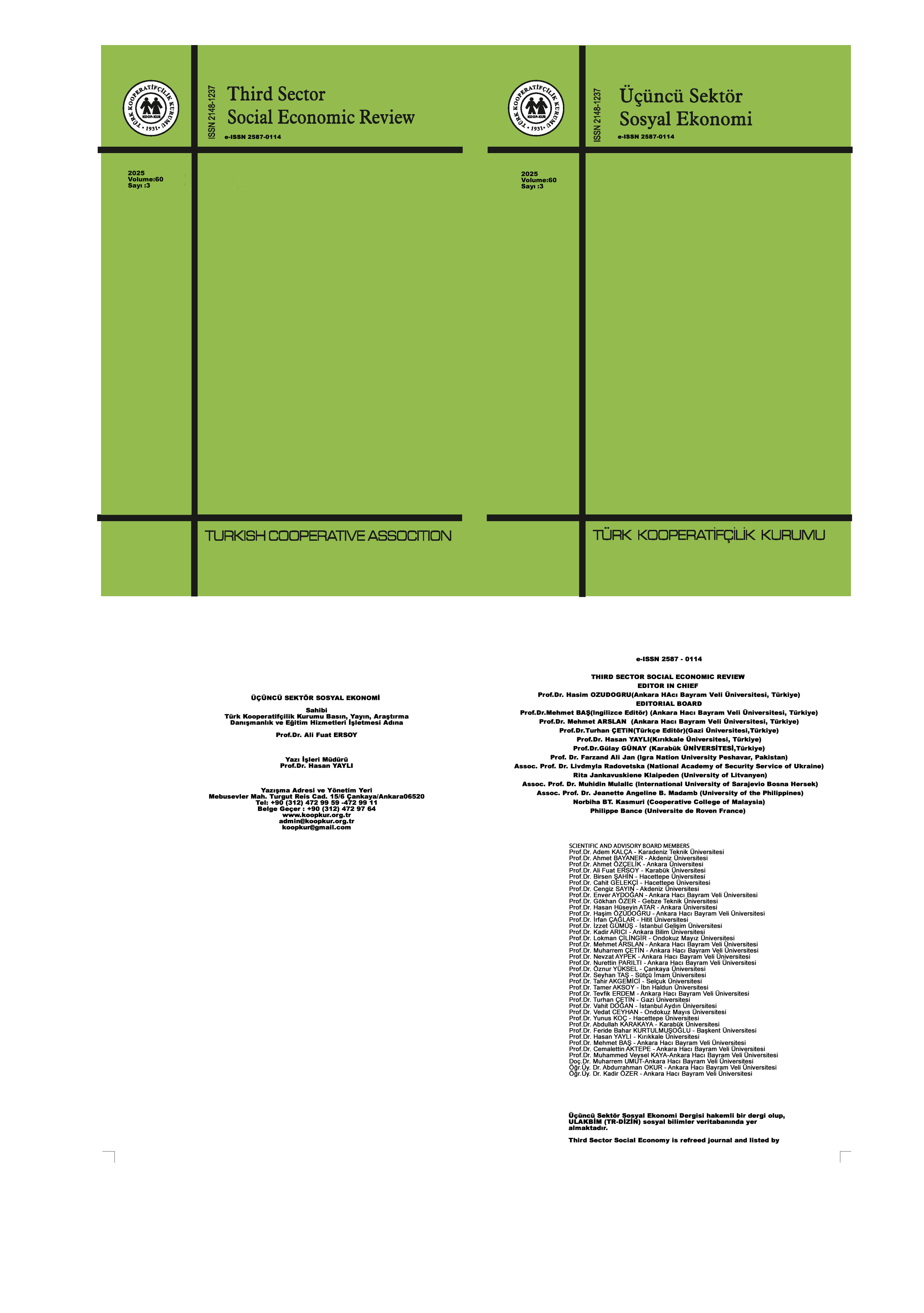The Demographic Analysis of Occupational Future Time Perspective: The Case of Artvin
DOI:
https://doi.org/10.63556/tisej.2025.1557Keywords:
Occupational Future Time Perspective, Demography, Future Time Perspective, Socioemotional Selectivity TheoryAbstract
This study aims to analyze how Occupational Future Time Perspective (OFTP) varies across demographic variables. OFTP refers to individuals’ perceptions of their remaining time in the workplace and how these perceptions influence their career goals, motivation, and behaviors. The research was conducted with 334 marketing and sales employees working in various sectors in the province of Artvin. Data were collected using the OFTP scale developed by Zacher and Frese (2009) and adapted into Turkish. The data were analyzed through independent samples t-tests and one-way ANOVA. The study examined the three subdimensions of OFTP focus on opportunities, focus on limitations, and perceived remaining time across participants’ gender, age, marital status, and tenure. The findings revealed that significant differences emerged only in the “perceived remaining time” dimension. Younger, single, and less tenured employees perceived that they had more time left in their careers compared to their older, married, and more experienced counterparts. In contrast, no statistically significant differences were found in the dimensions of focus on opportunities or focus on limitations based on demographic variables. The results indicate that individuals’ perceptions of occupational time are shaped by age, social roles, and organizational experience, suggesting that human resource strategies should consider these demographic factors in career planning and development.
References
Aaker, D. A., Kumar, V., & Day, G. S. (2007). Marketing research (9th ed.). Danvers, MA: John Wiley & Sons.
Baltes, M. M., & Carstensen, L. L. (1996). The process of successful ageing. Ageing and Society, 16(4), 397–422. https://doi.org/10.1017/S0144686X00003603
Bandura, A. (1997). Self-efficacy: The exercise of control. W.H. Freeman.
Birincioğlu, N. (2018). Örgütsel Davranış Odaklı Yönetsel Yaklaşımlar. In E. Aydoğan (Ed.), Gazi Kitabevi.
Birincioğlu, N. (2024). İş Yaşamında Gelecek Zaman algısı Ölçeğinin Türkçe Güvenirlik ve Geçerlik Çalışması. ETÜ Sentez İktisadi ve İdari Bilimler Dergisi, (13), 1–16.
Campbell, D. T., & Stanley, J. C. (1963). Experimental and quasi-experimental designs for research on teaching. In N. L. Gage (Ed.), Handbook of research on teaching (pp. [sayfa numaraları, eğer biliniyorsa]). Chicago, IL: Rand McNally.
Carstensen, L. L. (2006). The influence of a sense of time on human development. Science, 312(5782), 1913–1915. https://doi.org/10.1126/science.1127488
Cate, R. A., & John, O. P. (2007). Testing models of the structure and development of future time perspective: Maintaining a focus on opportunities in middle age. Psychology and Aging, 22(1), 186–201.
George, D., & Mallery, P. (2003). SPSS for Windows step by step: A simple guide and reference (4th ed.). Allyn & Bacon.
Gürbüz, S., & Şahin, F. (2018). Sosyal bilimlerde araştırma yöntemleri: Felsefe – yöntem – analiz (5. baskı). Seçkin Yayıncılık.
Henry, H., Zacher, H., & Desmette, D. (2017). Future Time Perspective in the Work Context: A Systematic Review of Quantitative Studies. Frontiers in Psychology, 8, 413. https://doi.org/10.3389/fpsyg.2017.00413
Husman, J., & Lens, W. (1999). The role of the future in student motivation. Educational Psychologist, 34(2), 113–125. https://doi.org/10.1207/s15326985ep3402_4
Kaiser, H. F. (1974). An index of factorial simplicity. Psychometrika, 39(1), 31–36. https://doi.org/10.1007/BF02291575
Keppel, G., & Wickens, T. D. (2004). Design and analysis: A researcher’s handbook (4th ed.). Pearson Education.
Kinnear, T. C. & Taylor, J. R. (1996). Marketing Research An Applied Approach, International Edition, McGraw Hill.
Kurtuluş, K. (2004). Pazarlama Araştırmaları, 7. Baskı, Literatür Yayıncılık, İstanbul.
Lang, F. R., & Carstensen, L. L. (2002). Time counts: Future time perspective, goals, and social relationships. Psychology and Aging, 17(1), 125–139.
London, M. (1983). Toward a theory of career motivation. Academy of Management Review, 8(4), 620–630. https://doi.org/10.5465/amr.1983.4284664
Malhotra, N. K. (2004). Marketing research: An applied orientation (4th ed.). Upper Saddle River, NJ: Pearson Prentice Hall.
Nakip, M. (2006). Pazarlama Araştırmaları Teknikler ve (SPSS Destekli) Uygulamalar, Seçkin Yayıncılık, Ankara.
Nurmi, J. E. (1991). How do adolescents see their future? A review of the development of future orientation and planning. Developmental Review, 11(1), 1–59. https://doi.org/10.1016/0273-2297(91)90002-6
Rudolph, C. W., Kooij, D. T. A. M., Rauvola, R. S., & Zacher, H. (2018). Occupational future time perspective: A meta-analysis of antecedents and outcomes. Journal of Organizational Behavior, 39, 229–248. https://doi.org/10.1002/job.2264
Tabachnick, B. G., & Fidell, L. S. (2019). Using multivariate statistics (7th ed.). Pearson.
Tavakol, M., & Dennick, R. (2011). Making sense of Cronbach’s alpha. International Journal of Medical Education, 2, 53–55. https://doi.org/10.5116/ijme.4dfb.8dfd
Zacher, H. (2013). Older job seekers’ career goals and application behavior: Moderating role of occupational future time perspective. European Journal of Work and Organizational Psychology, 22(6), 687–698. https://doi.org/10.1080/1359432X.2012.702420
Zacher, H. (2015). Successful aging at work. Work, Aging and Retirement, 1(1), 4–25.
Zacher, H., & Frese, M. (2009). Remaining time and opportunities at work: Relationships between age, work characteristics, and occupational future time perspective. Psychology and Aging, 24(2), 487–493. https://doi.org/10.1037/a0015425
Zacher, H., & Rudolph, C. W. (2021). Relationships between psychological contract breach and employee well-being and career-related behavior: The role of occupational future time perspective. Journal of Organizational Behavior, 42, 84–99. https://doi.org/10.1002/job.2495
Zacher, H., & Yang, J. (2016). Organizational climate for successful aging. Work, Aging and Retirement, 2(1), 73–85. https://doi.org/10.1093/workar/wav024
Zikmund, W. G. (1997). Business research methods (5th ed.). Orlando, FL: The Dryden Press.
Zimbardo, P. G., & Boyd, J. N. (1999). Putting time in perspective: A valid, reliable individual-differences metric. Journal of Personality and Social Psychology, 77(6), 1271–1288. https://doi.org/10.1037/0022-
Downloads
Published
How to Cite
Issue
Section
License
Copyright (c) 2025 Third Sector Social Economic Review

This work is licensed under a Creative Commons Attribution-NonCommercial 4.0 International License.







